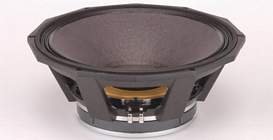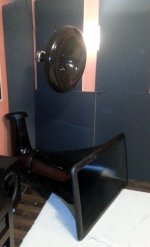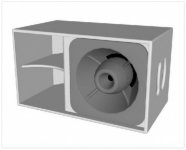Candidate Thuras Surrogates
Sans Carcass
Model PD2150/PD2151
Nom.Dia.: 21”
Dvc: 6”
Fs: 22/27 Hz
Sd: 1630/1688 cm^2
Xmax: 12.0/10.5 mm
Qts: 0.19/0.18
BL: 34.28/37.13 Tm
Vas: 628.0/474.8 L
Mms: 305/281 g
Precision Devices International Limited
Precision Devices International Limited
Regards,
WHG
Before we go into details let me simulate "Thuras" driver.
1) Outer diameter 20"
2) VC diameter 8"
3) Optimum coil mass for 8" is 32g
4) Membrane thickness is ca. 0.1mm
5) Membrane mass is then 8.3g (plus suspension)
6) Assumed Bl is 30Tm, Re=6R.
7) Total Mmd is then 40.3g
8) Resulting Fs=53Hz and Qt=0.12 for Cms=1.6E-04 m/N
9) Optimal throat S1=210cm2 for Rg->0.
Largest domestic horn S2=18000 cm2, length 400-500cm, Hypex 0.6.
Sans Carcass
Model PD2150/PD2151
Nom.Dia.: 21”
Dvc: 6”
Fs: 22/27 Hz
Sd: 1630/1688 cm^2
Xmax: 12.0/10.5 mm
Qts: 0.19/0.18
BL: 34.28/37.13 Tm
Vas: 628.0/474.8 L
Mms: 305/281 g
Precision Devices International Limited
Precision Devices International Limited
Regards,
WHG
Attachments
Last edited:
No progress so far and price of neo magnets has increased 3-4 times. Once we try spun aluminum diaphragms and apply diamond coatings on standard mid-high compression drivers we could move into bass compression drivers. Onkens and bass horns with classic woofers are good enough. We tried OB-Horn but results were less exciting however space saving.
No progress so far and price of neo magnets has increased 3-4 times. Once we try spun aluminum diaphragms and apply diamond coatings on standard mid-high compression drivers we could move into bass compression drivers. Onkens and bass horns with classic woofers are good enough. We tried OB-Horn but results were less exciting however space saving.
….anything??
Basshorn have despite the fact of reproducing low frequencies, which are more omnidirectional, clearly perceivable directionality, which is even more perceived in small rooms. I see no advantage to use them domestically anymore. Much better use a bass array.
Basshorn have despite the fact of reproducing low frequencies, which are more omnidirectional, clearly perceivable directionality, which is even more perceived in small rooms. I see no advantage to use them domestically anymore. Much better use a bass array.
Hello,
Perception of directivity Under 150Hz is something very hypothetical IMHO may be a bit more around 250Hz... but I surely cannot accept such opinion as " a bass horn has a perceivable directivity"...
Best regards from Paris,
Jean-Michel Le Cléac'h
Hello,
Perception of directivity Under 150Hz is something very hypothetical IMHO may be a bit more around 250Hz... but I surely cannot accept such opinion as " a bass horn has a perceivable directivity"...
Best regards from Paris,
Jean-Michel Le Cléac'h
Jean-Michel
of course it depends as well how big the bass horn is. If you have a basshorn that has the mouth size as big and high as the entire room wall, then distribution will be even. But most common bass horns we see around have a rather small mouth exit, so the radiation angle is rather limited, and the energy of the sound waves directional in a way that can be clearly perceived. That was a reason, why i did add two 15" woofers above my basshorn, having now even vertical distribution of bass in my room.
Last edited:
Jean-Michel
of course it depends as well how big the bass horn is. If you have a basshorn that has the mouth size as big and high as the entire room wall, then distribution will be even. But most common bass horns we see around have a rather small mouth exit, so the radiation angle is rather limited, and the energy of the sound waves directional in a way that can be clearly perceived. That was a reason, why i did add two 15" woofers above my basshorn, having now even vertical distribution of bass in my room.
Hello Angeloitacare,
I cannot call bass horn any VOT or Altec 211, JBL4550 and such
The lowest reproduced frequencies by them being is emitted by the bass-reflex part like in that example
http://www.artec-france.com/photos/salle-ecoute-2007.jpg
and even that one (in the middle) , I don't call this bass horn!
http://www.melaudia.net/zfoto/bretagne1205/P1040088-800x450.jpg
Only the upperbass range and midbass range being emitted through the small and too short horn part.
This is what I call a bass horn (and even this is a Le Cléac'h basshorn )
http://nsm01.casimages.com/img/2009/05/17//090517055721545253677910.jpg
http://www.melaudia.net/zfoto/bretagne1205/IMG_9967-800x533.jpg
And with such true bass horns the directivity is very low...
Best regards,
Jean-Michel Le Cléac'h
Jean Michel
1. What is the advantage of the bass horn ?
2. I can hardly imagine how you can have even distribution of bass vertically that way.
I'd say that would be the way to go :
http://www.diyaudio.com/forums/multi-way/35509-horn-vs-open-baffle-bass-5.html
If the goal of the horn is to have better transients, then maybe a slot loaded bass would do it as well ?
Angelo
1. What is the advantage of the bass horn ?
2. I can hardly imagine how you can have even distribution of bass vertically that way.
I'd say that would be the way to go :
http://www.diyaudio.com/forums/multi-way/35509-horn-vs-open-baffle-bass-5.html
If the goal of the horn is to have better transients, then maybe a slot loaded bass would do it as well ?
Angelo
Hello,
Perception of directivity Under 150Hz is something very hypothetical IMHO may be a bit more around 250Hz...
I have long had doubts about this as well, but I have searched in vain for any scientific studies that quantify how well humans can locate sound sources at various frequencies, in azimuth vs. elevation, etc.
Can anyone link me to one?
I will be interested in this also (under 150Hz directivity). It opens up flexibility in bass horn arrangements, potentially allowing them to enter the rear of the room to counter time alignment issues and reduce horn height and issues associated with mid bass horns in front of bass or sub bass horns.
Absolutely. It seems to be audiophile "common knowledge" that midbass frequencies are localizable. But if this is in fact not true, then stereo bass is a useless design goal, and summing to mono below 150 or 200Hz opens up all kinds of design flexibility for high-performance sub/satellite systems with much smaller L/R speakers.
Edit:
Midbass localization is off-topic for this thread, so if a mod would care to split these last three posts off into a new thread, that would be fine with me.
Edit:
Midbass localization is off-topic for this thread, so if a mod would care to split these last three posts off into a new thread, that would be fine with me.
Last edited:
My friend who use 50Hz up to several hundreds of Hz horn says it is an improvement because it's heart of music content - everything above is an adornment.
What's your experience with high Qms/Mms/Bl and low Rms drivers for bass horns like Eminence Lab? I've tried typical low Qts drivers in Hornresp but results are medicore.
What's your experience with high Qms/Mms/Bl and low Rms drivers for bass horns like Eminence Lab? I've tried typical low Qts drivers in Hornresp but results are medicore.
Maybe someone should start out with a simple PPSL before going to extremes. My set is very likeable.
Depending on ones needs they should consider using 8-10" woofers to use a smaller manifold for more midbass bandwidth.
Mine uses 15" woofers and goes to crap 2 octaves below where I'd like. But I do get full output below 24hz. A design that did well 70-400hz 96-100db might be reasonable and much easier that the designs in this thread.
Depending on ones needs they should consider using 8-10" woofers to use a smaller manifold for more midbass bandwidth.
Mine uses 15" woofers and goes to crap 2 octaves below where I'd like. But I do get full output below 24hz. A design that did well 70-400hz 96-100db might be reasonable and much easier that the designs in this thread.
3-way horn-loaded cabinet with Celestion CDX1-1446, TF1225 and TF0818MR
Is Albert L. Thuras alive?! Obvious not, but I find the design of this 3-way horn-loaded mid/high cabinet by James enough interesting to post it here. 😀
CABINET DESIGN WINNER! - Celestion Speaker World
http://celestion.com/speakerworld/downloads/patech/99.pdf
Is Albert L. Thuras alive?! Obvious not, but I find the design of this 3-way horn-loaded mid/high cabinet by James enough interesting to post it here. 😀
CABINET DESIGN WINNER! - Celestion Speaker World
http://celestion.com/speakerworld/downloads/patech/99.pdf
Attachments
- Status
- Not open for further replies.
- Home
- Loudspeakers
- Multi-Way
- DIY bass compression drivers


